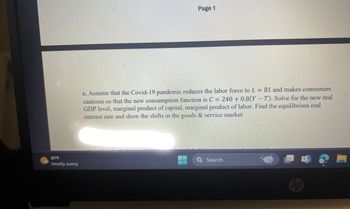
ENGR.ECONOMIC ANALYSIS
14th Edition
ISBN: 9780190931919
Author: NEWNAN
Publisher: Oxford University Press
expand_more
expand_more
format_list_bulleted
Question

Transcribed Image Text:81 F
Mostly sunny
Page 1
c. Assume that the Covid-19 pandemic reduces the labor force to L = 81 and makes consumers
cautious so that the new consumption function is C = 240 + 0.8(YT). Solve for the new real
GDP level, marginal product of capital, marginal product of labor. Find the equilibrium real
interest rate and show the shifts in the goods & service market.
Q Search
hp
SAVE
AI-Generated Solution
info
AI-generated content may present inaccurate or offensive content that does not represent bartleby’s views.
Unlock instant AI solutions
Tap the button
to generate a solution
to generate a solution
Click the button to generate
a solution
a solution
Knowledge Booster
Similar questions
- If real estate prices in the United States fall, this leads to A. An increase in real U.S. wealth, and an increase in AD B. A decline in real U.S. wealth, and an increase in AD C. A decline in real U.S wealth and a decrease in AD D. Both B and Carrow_forwardConsider the “circular flow” diagram for our economy. Explain what each of its components mean and how that detailed model of “incomes” and “expenditures” provides a foundation for economic theory?arrow_forwardam. 285.arrow_forward
- partBarrow_forward2. Over the past few years, one of the most closely monitored economic variables has been the inflation rate, which measures the change in the price level. Measuring it is complicated because different prices change by different amounts and sometimes in different directions (for example, the price of college tuition has been steadily rising for decades, whereas the price of TV sets has been decreasing). We can use the expenditure function to aggregate the change in the price level, by asking how much more it costs to achieve the same utility level under the new prices. That is, if the prices change from (P₁, P₂) to (P₁, P₂), where p₁ > p₁ and pź > P₂, we can define the inflation rate as: b. i 1 1 Suppose Bebel has a Cobb-Douglas utility, U = 9₁²9₂², and an income level of Y = 1600. Suppose p₁ = 100 and p = 100 so the price of good 1 doesn't change, but the price of good 2 increases from p₂ = 16 to p2 = 25. a. Calculate Bebel's optimal consumption bundle and utility level at the initial…arrow_forwardhi this question is for Macroeconomics but on bartleby it show economicsarrow_forward
- 3. Briefly explain whether production of each of the following goods is likely to fluctuate more or less than real GDP does during the business cycle: • Tesla Model 300 • McDonald's Big Macs Whirlpool Refrigerator Pampers Diapers ● You are required to explain your answers for each of the products listed above. Ensure you reference your data sources and any academic articles that support your answers. Hint: Graphing the answers may make it visually easier to determine your answer. Please include all graphs, charts, and diagrams in your assignment.arrow_forwardQ1 What is "capital"? The salary we pay employees Please give just answer. There is no need to explain. The money we pay to the government O Money invested in a building or machine to help us make products Money we make when customers pay us O None of the above Q2lf a country experiences high GDP and inflation, followed by a lower GDP and deflation, this is an example of O Unemployment Recession the Business Cycle O Supply and Demand None of the above Q3 What causes inflation? O People don't have enough money O People have too much money O People have too much money and many businesses want some of that money O People owe a lot of money O The government causes inflation by rais ing interest rates Q4 The Water and Diamond Paradox explains: O Why supply and demand always meets in the middle of a graph Marginal utility of diamonds O Why water is inexpensive while diamonds are so expensive O Why water is so expensive while diamonds are inexpensive O None of the above Q5 The unemployment…arrow_forward23. When an individual is considering borrowing to smooth consumption they will borrow just enough that A. B. C. D. فن the interest rate is less than their discount rate. they can consume equal amounts now and later. they can easily pay back the loan. the discount rate is equal to the interest rate.arrow_forward
arrow_back_ios
arrow_forward_ios
Recommended textbooks for you

 Principles of Economics (12th Edition)EconomicsISBN:9780134078779Author:Karl E. Case, Ray C. Fair, Sharon E. OsterPublisher:PEARSON
Principles of Economics (12th Edition)EconomicsISBN:9780134078779Author:Karl E. Case, Ray C. Fair, Sharon E. OsterPublisher:PEARSON Engineering Economy (17th Edition)EconomicsISBN:9780134870069Author:William G. Sullivan, Elin M. Wicks, C. Patrick KoellingPublisher:PEARSON
Engineering Economy (17th Edition)EconomicsISBN:9780134870069Author:William G. Sullivan, Elin M. Wicks, C. Patrick KoellingPublisher:PEARSON Principles of Economics (MindTap Course List)EconomicsISBN:9781305585126Author:N. Gregory MankiwPublisher:Cengage Learning
Principles of Economics (MindTap Course List)EconomicsISBN:9781305585126Author:N. Gregory MankiwPublisher:Cengage Learning Managerial Economics: A Problem Solving ApproachEconomicsISBN:9781337106665Author:Luke M. Froeb, Brian T. McCann, Michael R. Ward, Mike ShorPublisher:Cengage Learning
Managerial Economics: A Problem Solving ApproachEconomicsISBN:9781337106665Author:Luke M. Froeb, Brian T. McCann, Michael R. Ward, Mike ShorPublisher:Cengage Learning Managerial Economics & Business Strategy (Mcgraw-...EconomicsISBN:9781259290619Author:Michael Baye, Jeff PrincePublisher:McGraw-Hill Education
Managerial Economics & Business Strategy (Mcgraw-...EconomicsISBN:9781259290619Author:Michael Baye, Jeff PrincePublisher:McGraw-Hill Education


Principles of Economics (12th Edition)
Economics
ISBN:9780134078779
Author:Karl E. Case, Ray C. Fair, Sharon E. Oster
Publisher:PEARSON

Engineering Economy (17th Edition)
Economics
ISBN:9780134870069
Author:William G. Sullivan, Elin M. Wicks, C. Patrick Koelling
Publisher:PEARSON

Principles of Economics (MindTap Course List)
Economics
ISBN:9781305585126
Author:N. Gregory Mankiw
Publisher:Cengage Learning

Managerial Economics: A Problem Solving Approach
Economics
ISBN:9781337106665
Author:Luke M. Froeb, Brian T. McCann, Michael R. Ward, Mike Shor
Publisher:Cengage Learning

Managerial Economics & Business Strategy (Mcgraw-...
Economics
ISBN:9781259290619
Author:Michael Baye, Jeff Prince
Publisher:McGraw-Hill Education